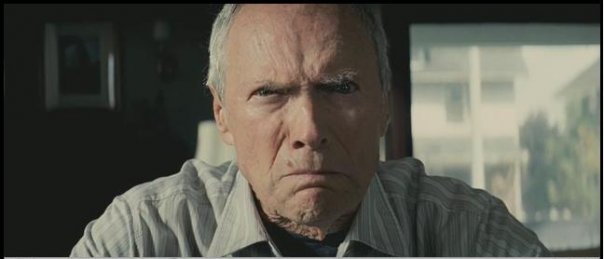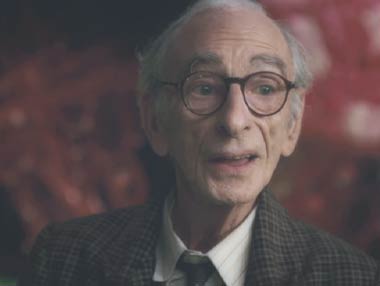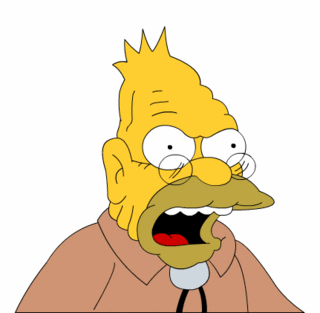In media we are constantly presented with stereotypes. Some of these stereotypes, for one reason or another become particularly popular and endure throughout time. One such stereotype is that old men are grumpy, tough and nostalgic. For the sake of simplicity, I will refer to this as the 'grumpy old man' phenomenon.
This is really just an introduction to the ideas that are explored on my three character posts on this blog. The stereotype under discussion is one of such strength and popularity that people ranging from young children to even the elderly themselves believe it to some extent. The extent to which we have been exposed to the grumpy old man stereotype and bombarded with it has caused it to take hold in society - not a great thing for old men.
What is perhaps devastating with a stereotype of this scale is the impact it has on the subjects. There was a time when you wouldn't dare disrespect an elderly man - in the wisdom hierarchy he ruled supreme. However something changed at some point which led this assumed respect to be disregarded. The fact is, many people genuinely believe all old men are this way.
I hope this will become clearer with examples. My other other three posts are dedicated to both proving the stereotype is common and also showing examples of contradictions to it. Please check them out.
Wounded Bull and Stubborn Mule - Grumpy Old Men in the Media
Wednesday 16 May 2012
Monday 14 May 2012
Walt Kowalski
 Here is a grumpy looking Walt Kowalski, the main character in the film 'Gran Torino' (played by Clint Eastwood). He is looking very menacing and intimidating - a kind of aggresive form of grumpiness, rather than a stroppy one as such. He's not the sort of person you would want to mess with evidently.
Here is a grumpy looking Walt Kowalski, the main character in the film 'Gran Torino' (played by Clint Eastwood). He is looking very menacing and intimidating - a kind of aggresive form of grumpiness, rather than a stroppy one as such. He's not the sort of person you would want to mess with evidently.
Walt is a veteran of the Korean war and is a recent widower, two things which have, presumably, led to his ever grumpy, unapproachable and hard skinned persona. It is interesting that Walt is a widower like Carl Fredericksen, and a war veteran, like Abe Simpson. He is almost the epitome of the 'grumpy old man' stereotype we are fed. Let's answer the three questions from the other two men.
1) How realistic is it? Is this the only way for this group of people to be?
Walt Kowalski is, as previously mentioned, the epitome of the grumpy old man stereotype under examination. He encompasses all of the aspects we are familiar with. He's a war vet, he's a widower, he's stern and always angry etc. Is this particularly realistic though? It's neither here nor there. Sure, there might be some bitter old war veteran men with no wives and an anger for the modern world. But at the same time, there may be kind old men in the world who are happily married, have no history of war, don't show resentment all the time and aren't hopeless nostalgists who believe things were so much better in their day.
 Take Mr Edward Magorium from the movie 'Mr Magorium's Wonder Emporium' for example. He is far from being a grumpy old man. In fact he is kind hearted, almost always smiling and believes in magic of a sort, representing almost the opposite of the stereotype. Mr Magorium is better described as a 'kind old man' who appears almost incapable of the kind of resentment the stereotypical archetype for his age and gender suggests. This alone is proof that grumpy and bitter is not the only way old men can be.
Take Mr Edward Magorium from the movie 'Mr Magorium's Wonder Emporium' for example. He is far from being a grumpy old man. In fact he is kind hearted, almost always smiling and believes in magic of a sort, representing almost the opposite of the stereotype. Mr Magorium is better described as a 'kind old man' who appears almost incapable of the kind of resentment the stereotypical archetype for his age and gender suggests. This alone is proof that grumpy and bitter is not the only way old men can be.2) What are the implications or issues around what they are choosing to highlight or ignore?
A problem with conveying the message that war veterans and widowers (and just old men in general) are always bitter and resentful, is that society can begin to believe the stereotype and act in a judgemental or demonising way towards them. What is unfortunately the case now is that many people hold prejudices towards old people (particularly old men) which are generated from a combination of ignorance of reality and media stereotypes. Look no further than Penn and Teller's 'Old People' episode of the show 'Bullshit' for proof of this. These prejudices lead to the ultimate marginalisation of the elderly in society, which in turn lead the elderly to a feeling of worthlessness and ostracism, depression and resentment. What the representation of eternal grumpiness is essentially doing, is turning younger people against the elderly, sabotaging the respect that used to be and should be owed to them, and making the elderly feel as if they don't hold a place in modern society. These are very dangerous and serious consequences for a seemingly innocuous representation.
Physical health correlates of attitudes toward aging in the elderly.
Abstract
Attitudes toward aging were assessed in three groups of elderly men (age 65-85), including: hospitalized veterans, veteran outpatients, and a group of non-hospitalized "healthy" veteran volunteers, using the Rosencranz and McNevin Semantic Differential Scale. Social objects rated included an "old man", a "young man", and the participant, himself, ("self"). Attitudes toward "old men" were significantly more negative than attitudes toward "young men" in all three groups. In addition, significant group by "object-rated" interactions were obtained on the autonomous/dependent and instrumental/ineffective dimensions of this scale. These interactions were attributable to a more negative "self" rating by the hospitalized group. These results suggest that within the population studied, older persons in poor health tend to view themselves more like the stereotyped "old person" than do healthy old people, who tend to perceive themselves as being more like a "young person". (from PubMed)
3) How effective are the features (techniques) in creating the representation?
Let's look at the picture of Walt Kowalski at the top left of the post. His eyebrows are furrowed, his face muscles are tightened and he is frowning. His eyes are also narrowed and he is leaning forwards intimidatingly. Overall, this picture has done very well at conveying grumpiness and angriness in an old man. Mr Magorium on the other hand has done very well at conveying the opposite. Every single feature that Walt Kowalski possesses is the opposite in the picture of Mr Magorium. His eyebrows are in a normal position, his face muscles are relatively relaxed, he is smiling, his eyes are open and friendly and he is not leaning forwards in an intimidating way. Magorium is the polar opposite of Kowalski here and he is portraying the contradicting character of a kind, friendly old man. Both pictures use clear features to convey their given archetype with clarity, and in a way that will get through to all people.
Thursday 10 May 2012
Carl Fredricksen
On the right of the picture is 'Up' character Carl Fredricksen, a perfect example of a grumpy old nostalgic man. In the first half of the film at least, Carl is a cranky character who does not have the patience for anyone or anything, and he is driven only by the desire to see wild South America. He frequently remembers his time with Ellie in a longing way, and is undeniably a nostalgist.
This picture demonstrates the difference in attitude between the youthful child and Carl himself, an old man who society marginalises. His old age and loss of Ellie have given him a sad and grumpy demeanour.
1) How realistic is it? Is this the only way for this group of people to be?
 Firstly, we are dealing with a Pixar film. Based on that information alone, we know we will be presented with an array of familiar stereotypes. Carl Fredricksen is portrayed EXTREMELY stereotypically in this film. There is not one feature associated with old age that Carl is not displaying. He has grey hair, wrinkled skin, spectacles, a grumpy countenance, dull formal clothing and a walking stick (albeit a strange one). In reality, not all old men are like this. Certainly not all old men bear grumpy expressions all the time either. You don't catch Jack Nicholson staring down the paparazzi all the time, and he's 75.
Firstly, we are dealing with a Pixar film. Based on that information alone, we know we will be presented with an array of familiar stereotypes. Carl Fredricksen is portrayed EXTREMELY stereotypically in this film. There is not one feature associated with old age that Carl is not displaying. He has grey hair, wrinkled skin, spectacles, a grumpy countenance, dull formal clothing and a walking stick (albeit a strange one). In reality, not all old men are like this. Certainly not all old men bear grumpy expressions all the time either. You don't catch Jack Nicholson staring down the paparazzi all the time, and he's 75.
Once again, not all elderly men are myopic, crippled, old fashioned and miserable, as this stereotype aims to convince us. Pictured above is the late David Kelly as Grandpa Joe Bucket in 'Charlie and the Chocolate Factory.' While he may fit the first three criteria, he hardly fits the fourth. Grandpa Joe is anything but miserable - his body may be ancient but his spirit is youthful and he is not the bitter, grumpy old man that the media would usually throw at us.
2) What are the implications or issues around what they are choosing to highlight or ignore?
Like 'The Simpsons,' animated movies like 'Up' have a huge child following. If people are sponges who absorb messages that are being given to them, children are the super absorbant variety. If you tell a child that old men are decrepit and cranky, they will believe it. It is in the nature of children to believe and potentially apply what they are told and shown. There is therefore always the chance that a viewer will take the message too seriously and start bullying and speaking negatively of old men. The implications aren't likely to be overly serious but this is dependent on the reasoning and education of the viewer concerned.
3) How effective are the features (techniques) in creating the representation?
The advanced animation used in 'Up' makes the character of Carl look quite realistic. Pixar has everything from his posture to his clothing to his facial expression down to a fine art and thus creates a skilful old man stereotype. Integral to Carl's grumpy look of course is the eyes and mouth. The eyes are drawn and flat while the mouth is shaped to form an obvious frown. A general feeling of impatience is given by Carl in the image, a feeling which gives rise to grumpiness itself. This is an effective picture in creating the 'grumpy old man' representation.
Wednesday 9 May 2012
Abe Simpson
Pictured here is Simpsons character Abe Simpson, looking grumpy, as his archetype intends. His character was apparently written to demonstrate the cranky stereotype of old men that many people hold, supporting the idea that elderly men are portrayed as grumpy nostalgists who can't be bothered with anything in the modern day.
Also, Abe Simpson is a veteran from both World Wars which makes him a hard, quick tempered character. Often examples of grumpy old men are characterised by their history of participation in war of some kind.
1) How realistic is it? Is this the only way for this group of people to be?
As with every case of stereotype, sometimes it does fit the bill. Sure, you may find grumpy old nostalgic men who are tough skinned and cranky, if only for their impatience with everything. But just because the media bombards us with this message, does not mean all old men are like this. Take a man like the one pictured on the right: Alfred from The Dark Knight is nothing if not wise,
consoling, friendly and above all good humoured. He is not especially nostalgic either.
There are also many other examples of ungrumpy old men, such as Lucius from the same film. The list of contradictions to the stereotype is endless.
2) What are the implications or issues around what they are choosing to highlight or ignore?
With a TV show such as the Simpsons that has a huge following, many of whom are probably children, any messages conveyed have the risk of being taken a little too seriously. Much like copycat serial killers go too far with fictional crimes and enact them in the real world, so too do people with messages. The idea that all old men are grumpy buggers is so familiar to us and ingrained in us that if we're not careful we might actually start to believe it. While more mature people are likely to take this stereotype with a grain of salt and sift fact from fiction, younger minds who haven't yet developed that sort of reasoning and haven't seen both sides of the story are at real risk of being brainwashed.
3) How effective are the features (techniques) in creating the representation?
This is a very interesting question as it brings to light the extent to which the media is able to manipulate consumers. When we first lay eyes on Abe Simpson in the top left we think 'It's an old man who looks angry.' That is not just an aspect of what the image is, that is the image in its entirety. The image serves to draw a connection between old age in men and a cranky attitude.
The features of the picture are extremely basic and extremely effective. We have the wrinkles representing old age and the eyebrow and mouth positions showing anger. On the surface it is a simple cartoon image, but at the deeper level it's a simple cartoon image that fulfils the stereotype we are so often bombarded with - the 'grumpy old man' one.
Subscribe to:
Posts (Atom)



